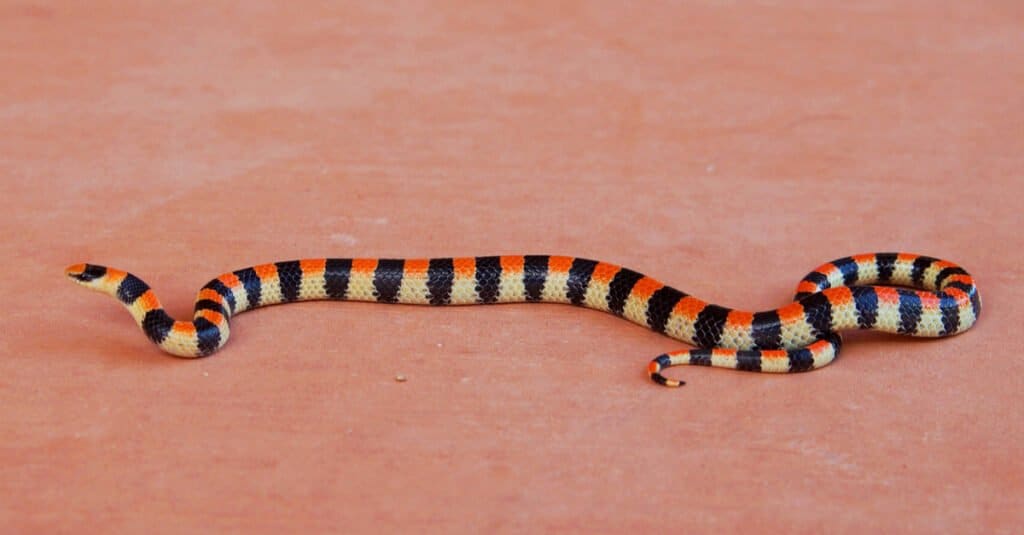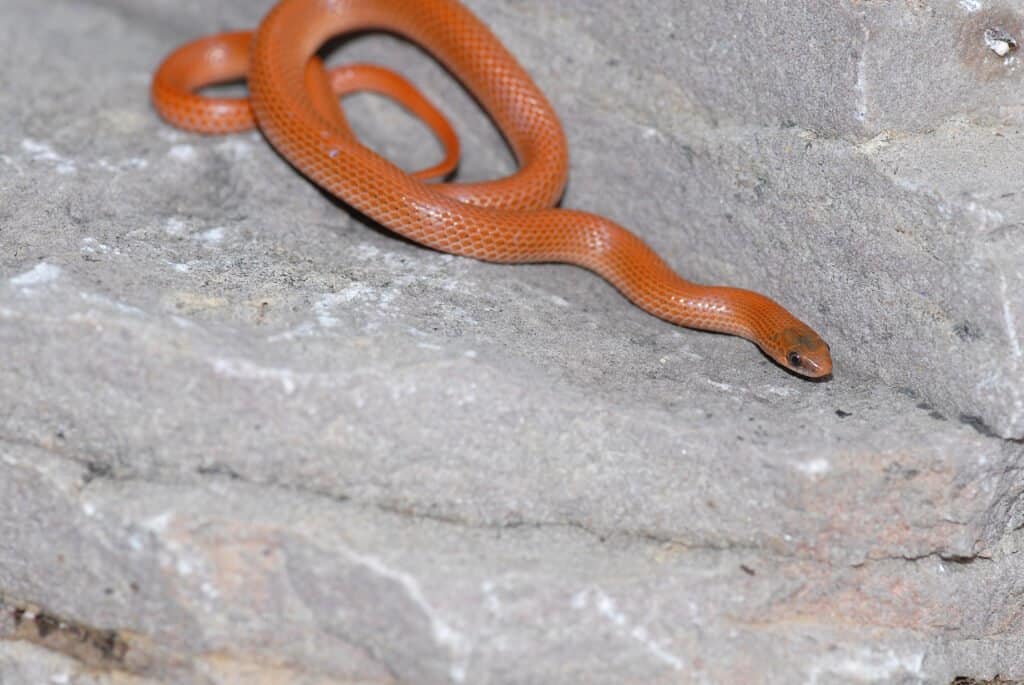Ground Snake
.jumbotron {
background-image: url(“https://a-z-animals.com/media/2022/04/Western-Ground-Snake-400×300.jpg”);
}
}
@media only screen and (min-width: 641px) and (max-width: 920px) {
.jumbotron {
background-image: url(“https://a-z-animals.com/media/2022/04/Western-Ground-Snake-470×370.jpg”);
}
}
@media only screen and (min-width: 921px) {
.jumbotron {
background-image: url(“https://a-z-animals.com/media/2022/04/Western-Ground-Snake.jpg”);
}
}
Ground Snake
Sonora semiannulata
It’s sometimes called a miter snake due to the marking on its head that looks like a bishop’s miter
Ground Snake Scientific Classification
- Kingdom
- Animalia
- Phylum
- Chordata
- Class
- Reptilia
- Order
- Squamat
- Family
- Colubridae
- Genus
- Sonora
- Scientific Name
- Sonora semiannulata
Read our Complete Guide to Classification of Animals.
Ground Snake Conservation Status
Ground Snake Facts
- Prey
- Centipedes, crickets, spiders, insect larvae
- Name Of Young
- snakelets, hatchlings
- Fun Fact
- It’s sometimes called a miter snake due to the marking on its head that looks like a bishop’s miter
- Estimated Population Size
- 100,000
- Biggest Threat
- Larger snakes
- Most Distinctive Feature
- A thick head
- Distinctive Feature
- Color patterns, including orange, red or brown with horizontal black bands, can vary widely, making it difficult to identify two individuals as the same type of snake!
- Other Name(s)
- Common ground snake, variable ground snake, and the miter snake
- Temperament
- Shy, non-aggressive
- Habitat
- These snakes live in a rocky hillside habitat where they can burrow into the loose, sandy ground.
- Diet
- Omnivore
- Common Name
- Western Ground Snake
- Special Features
- A thick head and body and round pupils
- Number Of Species
- 1
This post may contain affiliate links to our partners like Chewy, Amazon, and others. Purchasing through these helps us further the A-Z Animals mission to educate about the world’s species..

Discover alligator-eating snakes, spiders larger than your phone, and 1000 more incredible animals in our daily FREE email.
.photo-gallery {
–margin: 0px auto 0px;
–padding: 0px 0px 0px 0px;
}
.gallery-link {
background-image: url(“https://a-z-animals.com/media/2022/04/Western-Ground-Snake-1024×1024.jpg”);
background-repeat: no-repeat;
background-size: cover;
background-position: center;
height: 500px;
justify-content: center;
text-align: center;
align-items: center;
display: flex;
border: 2px solid #000;
}
.gallery-link img {
height: 50%;
}
@media only screen and (max-width: 768px) {
.gallery-link {
height: 300px !important;
}
}
View all of the Ground Snake images!
The western ground snake uses its thick head to dig burrows in its sandy habitat.
The western ground snake goes by a couple other names including the common ground snake and the variable ground snake. It’s native to North America, specifically the southwestern portion of the United States as well as northern Mexico. This snake has a variety of color patterns including orange, red, or brown with horizontal black bands.
This non-venomous snake grows to an average of about eight inches long, making it a manageable pet for some reptile enthusiasts.
button.pulse {
transform: scale(1); animation: pulse 2s infinite;
box-shadow: 0 0 0 0 rgba(11, 247, 25, 1);
}
@keyframes pulse {
0% { transform: scale(0.90); box-shadow: 0 0 0 0 rgba(11, 247, 25, 0.5); }
60% { transform: scale(1); box-shadow: 0 0 0 15px rgba(11, 247, 25, 0); }
100% { transform: scale(0.90); box-shadow: 0 0 0 0 rgba(11, 247, 25, 0); }
}
4 Amazing Facts
- This small snake uses its thick head to burrow into the sand and loose dirt in its habitat
- Because of its small size, this snake is preyed upon by larger snakes including the sidewinder
- It is sometimes mistaken for the similar-looking rough earth snake whose territory extends into the eastern part of the United States
- It’s sometimes called a miter snake due to the marking on its head that looks like a bishop’s miter
Where to Find Ground Snakes
Western ground snakes are found in the southwestern part of the United States. Its territory runs to the west from Missouri through Arizona and into California. This snake’s range also extends north into parts of Oregon. In addition, it’s found in Durango, Sonora, and Coahuila in northern Mexico.
These snakes live in a rocky hillside habitat where they can burrow into the loose, sandy ground. They are particularly active during their breeding season in the spring and in the summer when they lay their eggs.
In some regions, these snakes go into brumation when the weather becomes colder in November. This period of brumation allows them to keep warm and save their energy for breeding season. Western ground snakes come out of brumation in the later part of February or early in the month of March.
Scientific Name
Sonora semiannulata is the scientific name of the western ground snake. Other names of this snake include the common ground snake, variable ground snake and the miter snake. The Spanish word Sonora refers to its home in the Sonoran Desert in Arizona. The word semiannulata refers to its colorful scale pattern. This reptile is sometimes called a miter snake because some of them have a black mark on their head similar in shape to a bishop’s miter.
It is in the Reptilia class and the Colubridae family.
The Different Types of Western Ground Snake
Though the western ground snake doesn’t have subspecies, the snake comes in an array of colors and patterns. All of them have a cream-colored ventral area, which can help a person differentiate them from other small makes such as the flat-headed and red-bellied snakes. The scales of the common ground snake are also smooth, while those of snakes such as the similar-looking rough earth snake are keeled. The western ground snake can be told apart from other members of Sonora by differences in their tails or noses. Scientists sometimes but not always can tell the snakes apart by simply noting where they live.
Western ground snakes can come in solid colors, which are most often shades of brown, gray, orange, or red. They can be striped, or have full or partial bands. Bands are usually black, though some snakes found in west Texas have gray cross bands. The color patterns of the snake do not change with age and do not disclose the animal’s sex.
Population & Conservation Status
The population of the western ground snake is estimated at more than 100,000 and its numbers are stable. It’s listed by the conservationists at the IUCN Red List of Threatened Species as Least Concern.
Ground Snake Appearance and Description
The colors and markings of the non-venomous, western ground snake can vary. In short, this snake can be solid in color with light brown or red scales with a white belly. Or, it could have red or orange scales featuring black bands running the length of its body as well as on its belly. In other words, you could see two western ground snakes side by side and think you’re looking at two different species of snake!
Western ground snakes with solid brown scales are sometimes mistaken for another species of non-venomous ground snake. Officially, it’s known as a rough earth snake and is about the same length as a western ground snake.
The territories of these two snakes overlap. However, the territory of the rough earth snake aka ground snake, extends into the eastern part of the United States. Specifically, they inhabit an eastern range running from Virginia down to the northern part of Florida.
Western ground snakes are an average of eight inches long but can be as long as 20 inches. They have a thick body along with a uniformly thick head. This snake’s eyes have round pupils. This snake is nocturnal. So, it uses both its vision and sense of smell to find prey in the dark. Their insect prey of centipedes, spiders and crickets are nocturnal as well.
How to identify a western ground snake:
- Solid in color with shiny brown or red scales
- May also have a pattern of brown, orange, or red scales with horizontal black bands
- An orange or red snake with black bands can have a miter shape on its head
- A white belly or one with a banded pattern
- Thick head and body
- Round pupils
Western Ground Snake Pictures

Matt Jeppson/Shutterstock.com

Matt Jeppson/Shutterstock.com

Rusty Dodson/Shutterstock.com
How Dangerous Are They?
These snakes are not venomous. In addition, due to their small size, their bite is not painful.
A person who is bitten by one of these snakes may not even realize it. But, if a person is bitten, there are certain steps to take to avoid infection. First, the person should thoroughly clean the wound with soap and warm water. Next, it’s a good idea to put first-aid ointment on the bite area before putting a clean bandage over it. As a note, this snake’s teeth are very small and may not even be strong enough to penetrate a person’s skin. If swelling or excessive redness occurs, see a medical professional for treatment.
Ground Snake Behavior and Humans
Common ground snakes have a shy temperament and hide in burrows they build in loose sand or soil. If they see a human approaching or sense a predator in the area, they will try to get away.
Normally, these snakes are active at night. But someone walking in their rocky hillside habitat during the day may find one by lifting a rock or looking beneath a pile of dense vegetation. These snakes take cover during much of the day to stay cool in their extremely hot environment. Of course, surprising this snake in the daytime could result in a bite. It’s best to leave them alone in their hiding places.
Some people choose this snake as a pet because of its small size and shy nature. But it can be challenging to recreate its natural environment and diet.
Common ground snakes are rarely seen by humans because they live in habitats with soil they can easily burrow under. They are also nocturnal, which means they hunt at night. Sometimes a gardener may find one if they turn over the soil or leaf litter in their garden, and, like earthworms, a good rain can wash them to the surface. They are completely harmless to humans and don’t even seem to bite in self-defense.
As for keeping the snake as a pet, some experts believe that the common ground snake needs such specialized care that it doesn’t really make a good pet, despite the fact that it is a small, nonvenomous, and often very pretty snake. Others believe they make good pets that are easy to care for, even if they are a little secretive. They just need a 10-gallon tank with an earthen substrate and a rock the snake can hide under. After that, the rest of the snake’s care involves providing small insects and a water dish.
The variable ground snake probably mates from May to June and lays one to six eggs during the summer months. It is believed to lay the eggs underground, where they incubate for about two months before they hatch. Unlike some snakes where juveniles and adults look very different from each other, baby ground snakes look very much like adults, and they keep their patterns and colors throughout their lives.
The western ground snake is common in its range and its conservation status is least concern. This innocuous snake is prey for many other animals, including other snakes, lizards, and mammals. They have even been known to be taken by invertebrates such as large centipedes.
Why is it called a variable ground snake?
Sonora semiannulata is called a variable ground snake because it can come in so many different types of morphs. It can come with stripes, full bands or partial bands, or even in solid colors. For a long time, scientists believed these different color morphs were different subspecies of the snake.
View all 115 animals that start with G
Ground Snake FAQs (Frequently Asked Questions)
Are ground snakes venomous?
No, this snake is not venomous. Because this snake is very small and non-venomous, the only way it can defend itself against predators is to try to get away to hide in a burrow, beneath vegetation, or under a rock.
What do ground snakes eat?
These snakes are carnivorous, with a diet of centipedes, crickets, spiders, and insect larvae.
How do ground snakes hunt?
It hunts at night, moving slowly through its rocky habitat. It strikes quickly capturing its prey of small insects.
Are ground snakes aggressive?
No. These are shy snakes with a docile nature. This is why some people choose it as a pet for their household.
Keep in mind that despite its small size and docile nature this snake can be difficult to care for because of its special habitat. It needs a certain amount of sand or loose soil to dig in to make burrows. Plus, it needs to live in a habitat with a carefully maintained temperature, so it continues to eat, absorb vitamins, and remain healthy.
Where do ground snakes live?
Common ground snakes live in the southwestern part of the United States. Their range goes from Missouri west to Arizona and into California. Some of these snakes inhabit northern areas such as Oregon as well. Common ground snakes live in the northern area of Mexico including Coahuila, Durango, and Sonora.
In terms of habitat, this snake lives on hillsides covered with rocks and sandy, loose soil. It hides under rocks and in burrows for most of the day. However, this snake will come out to bask on a rock in the sunlight to warm up.
What are ground snakes called?
Western ground snakes are called variable ground snakes because of their varied coloration and patterns. These snakes can be a solid dark brown, light brown or red. Or, they can have orange or red scales with horizontal black bands running the length of their body and tail.
Western ground snakes of various colors mate with one another introducing even more variations in appearance.
These snakes also go by the name miter snake because they have a mark on their head that resembles a miter or headdress, worn by a bishop. Finally, they are sometimes called common ground snakes.
Sources
- Wikipedia, Available here: https://en.wikipedia.org/wiki/Western_ground_snake
- USA Snakes, Available here: https://usasnakes.com/sonora-semiannulata-western-ground-snake/
- IUCN Redlist, Available here: https://www.iucnredlist.org/species/63925/12728616
- Reptiles of AZ, Available here: https://reptilesofaz.org/snakes-subpages/h-s-semiannulata/
- Wikipedia, Available here: https://en.wikipedia.org/wiki/Haldea_striatula
- Digital Atlas of Idaho, Available here: https://digitalatlas.cose.isu.edu/bio/reptile/serp/sose/sosefram.htm
















